 The RCN (Royal canadian Navy) played a great part in the battle of the Atlantic during WW2, with considerable assets. However it was born in 1910 and already tested during the Great war.
The RCN (Royal canadian Navy) played a great part in the battle of the Atlantic during WW2, with considerable assets. However it was born in 1910 and already tested during the Great war.
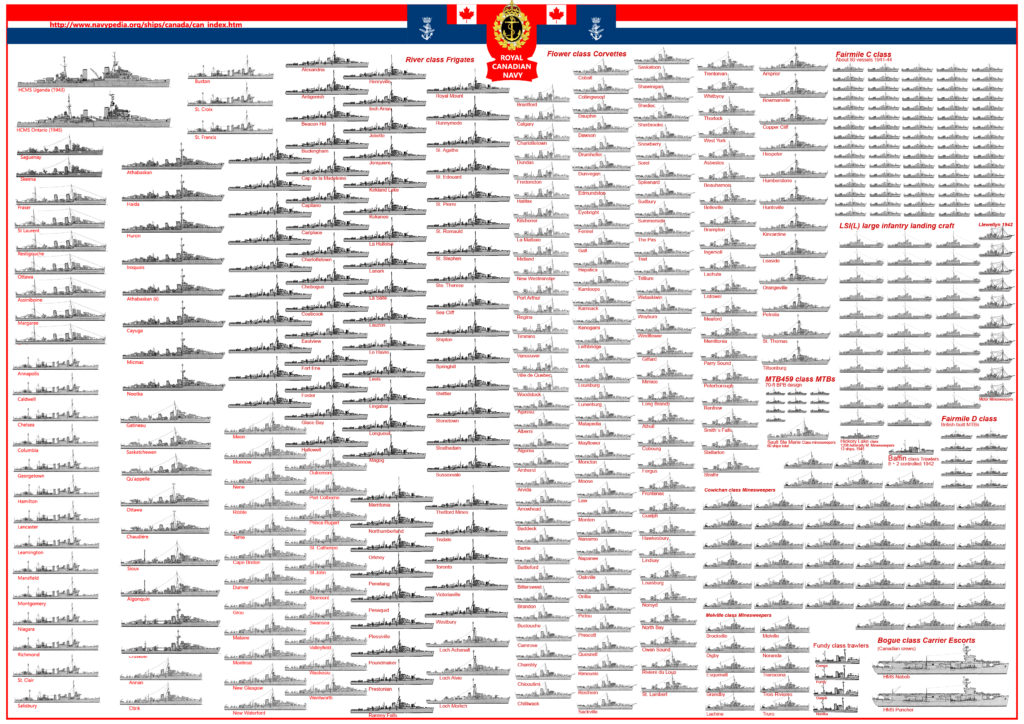
Poster of the RCN as it was in 1945. All the individual ships, with the exception of three classes presented with a single unit, because of size constraints;
Origins, with the Naval Service of Canada (1910)
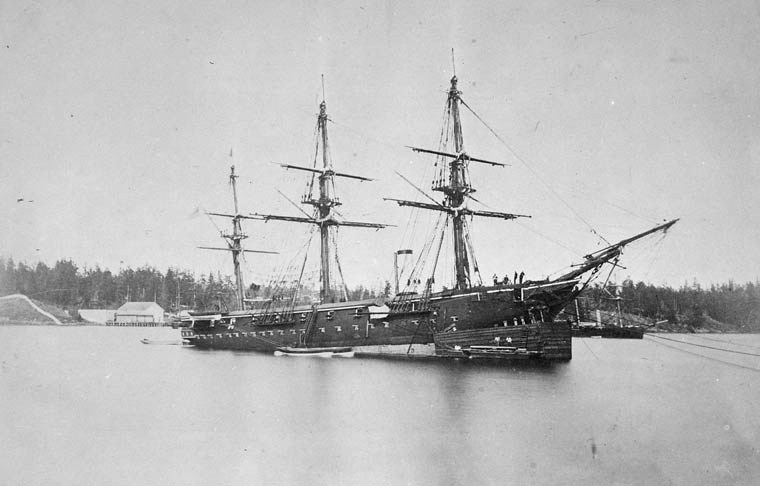
A very early attempt to give Canada a proper warship went back to Governor General Lord Dufferin, which asked the transfer of a British vessel to train local militia, according to a new law of 1868. This was the 1859 wooden steam-auxiliary corvette HMS Charybdis, transferred in July 1881. Outside training it was deployed also as flagship of the the Marine and Fisheries organization. In poor conditions she broke her mooring and derived, collided with two merchant steamers. American Poachers violated territorial waters at many occasions, despite the Anglo-American Treaty of Washington of 1871. However tensions emerged with the rise of the German Navy.
Creation of the RCN
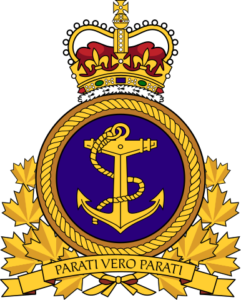 The beginning of the Century saw a debate raging inside the government on the question of the participation of the Dominions to their share of duty, either financial or direct.
The beginning of the Century saw a debate raging inside the government on the question of the participation of the Dominions to their share of duty, either financial or direct.
Articles Made and to come
The main triggers has been the naval arms race with Germany. Eventually the option of Canada, the richest and most developed Dominion, participating by provide funds, support and manpower to the Royal Navy, was rejected as it was preferred (and though as more politically acceptable by the first concerned) to create a local navy that could be managed autonomously and bring it’s direct support to the Royal navy. The same policy was observed later for Australia, leading to the creation of the RAN, and the RNZN.
Therefore the Royal Canadian Navy (RCN) was proposed by George Foster at the house of commons on 29 March 1909, and adopted by the Canadian government of Sir Wilfrid Laurier in 1910. It was acted on 4 May 1910 as the Canadian Naval Service and changed as the Royal Canadian Navy on 30 January 1911 (Canadian proposal) which was accepted by the King. Rear-Admiral Charles Kingsmill was named its first director.
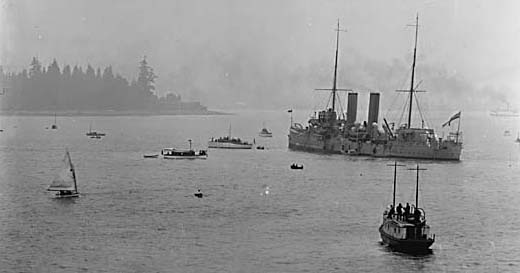
HMCS Rainbow off Vancouver, nearby the Japanese Komagata Maru.
The Naval College
Soon, a naval college was established in the dockyard at Halifax, Nova Scotia. After the 1917 explosion it was moved to the HMCS Stone Frigate. Afterwards, the Royal Canadian Naval College was relocated in a building in the naval dockyard at Esquimalt, British Columbia in 1919. Three years after it was closed. Charles Kingsmill suggested in 1910 a planned fleet of five cruisers and six destroyers. They were to be obtained in UK since no Canadian yard had experience with warships yet.
And in August 1910, the first Canadian cruiser was commissioned, HMCS Rainbow. This was a 1891 Apollo-class protected cruiser named HMS Rainbow. She trained cadets until struck on 1 June 1920. It was joined by HMCS Niobe, on 6 September 1910.
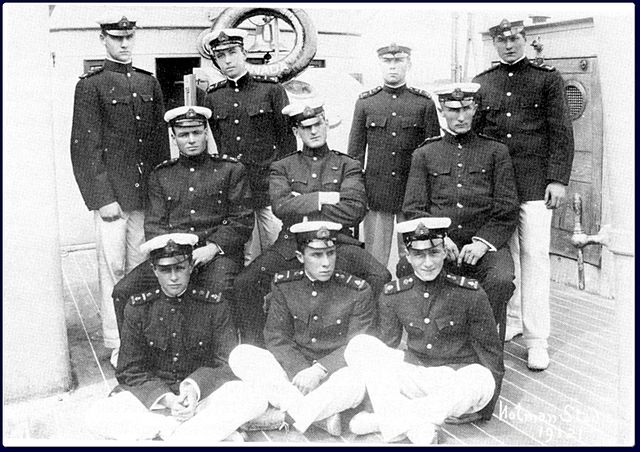
———–
A rocky existence before 1914
In 1911 a new Conservative government, led by Robert Borden was elected. It was hostile to the Naval Service Act but accepted the urgent request or Sir W. Churchill to finance three dreadnoughts, amongst fears of German winning the current “dreadnought race”, pressured by the house of commons and “battleship trust” asking vehemently “we want eight and we won’t wait”. On 5 December 1912, Borden introduced the Naval Aid Bill. It was adopted 15 May 1913, soon to be rejected by the new Liberal-majority Senate.
The RCN idea was put in jeopardy. However it also had its supporters and a volunteer reserve was created in May 1914 as the Royal Naval Canadian Volunteer Reserve (RNCVR). Its only 1,200 men manned the three distinct areas: Atlantic, Pacific, and Lake. However after the war broke out it will be extended enormously while an Overseas Division was established to serve with the Royal Navy.
The RCN in the Great War
Immediately the Royal Navy thought of bolstering the RCN in order to take charge of its sector, with on 5 August 1914, the CGS Canada (later HMCS Canada) being transferred and the CGS Margaret. The first was a 500 tons patrol ship armed with 12 and 3-pdr guns and the second, was also a patrol ship designed for the Customs and Preventative Service Canada. However, these were still weak addition made for a loca use.
The previous cruisers, Niobe and Rainbow were second or third class ships already obsolete in 1914. The Royal Navy had the survivors, mothballed, converted for various uses, such as blockships. However the fleet soon received the submarines CC-1 and CC-2. A massive extension was planned, but before it could take place, Canadian men would be permitted to enlist in the Royal Navy (and later return to the RCN).
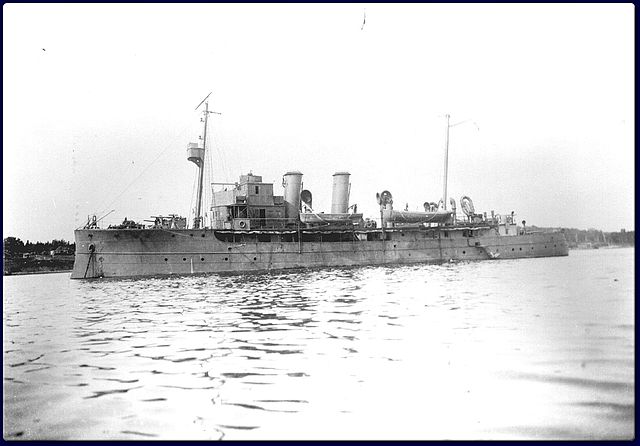
HMCS Margaret (1914)
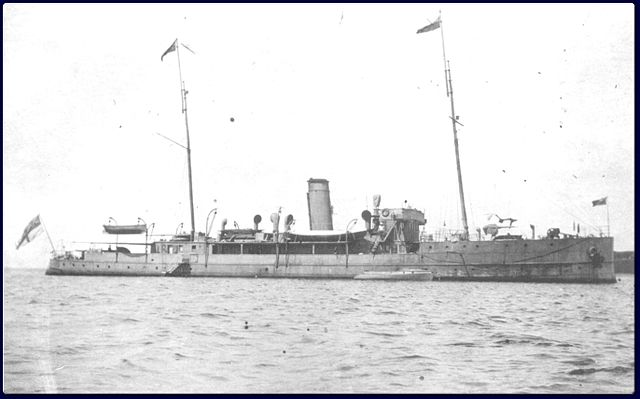
HMCS Canada (1904)
Patrols started immediately, over very long distances, from the north west coast of North America, and as far south as Panama. After the threat of Graf Spee’s squadron was eliminated, they resumed on the east coast. However in 1916 the ship’s crew was soon affected elsewhere and the ship was discarded in 1917. HMCS Niobe also served along the east coast and as part of the British blockading forces, but she was converted as a depot ship in Halifax in July 1915, and heavily damaged in the December 1917 Halifax Explosion. CC-1 and CC-2 patrolled the pacific and were lated based in Halifax.
Their tender, HMCS Shearwater, was the first Canadian warship to cross the Panama canal. More ships were added and the first losses due to subamrines, like the most server, in June 1918, HMHS Llandovery Castle. The fleet has also the Canadian Armed Yacht Stadacona (ex-Columbia) (1893, 780 tons, one 102mm, 1 x 76 mm. She was discarded in 1920. She was hired in 1916 for patrol and examination service.
But the bulk of the RCN during the great war was undoubtedly made of numerous minesweepers, called P.V. and TR type minesweeping trawlers.
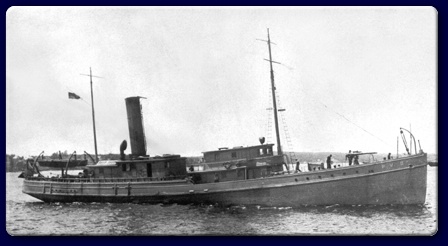
These 300 tons vessels indeed were built prior to the war in 1903–1912 in US Yards of Noank, Connecticut, Essex, mass. and Rockland, Maine. They were capable of 8 knots and armded with a single QF 12-pounder (76 mm) gun. Seven were pressed in Canadian service from 1917 and were reformed in 1919 and given back to civilian duties. On the other hand, the TR type were far more numerous: They were close to the British Castle class, 275 tons, using a 480 hp VTE engine for 10 knots and armed with a single QF 12-pounder (76 mm) gun. No less than about 53 were completed in eight yards in Canada (60 hulls ordered), originally for the Royal Navy.

Canadian TR-9 in 1918
RCNAS (1918)
The air service was created in September 1918, called Royal Canadian Naval Air Service (RCNAS). During the last days of the war it was based at the U.S. Navy’s Naval Air Station Halifax (monitorning the Nova Scotia passage), well equipped with seaplanes, but discontinued after the war ceased. Two stations existed, at North Sydney and Halifax. They proved useful, albeit not numerous. Indeed 110,000 tons of shipping has been sunk on North American shores in October-November 1918 alone. The Air Board took control of both stations when the RCNAS was disbanded in 1918. The installation stayed closed until WW2 and were reactivated and modernized, as well as the RCNAS, which was given escort aircraft carriers.
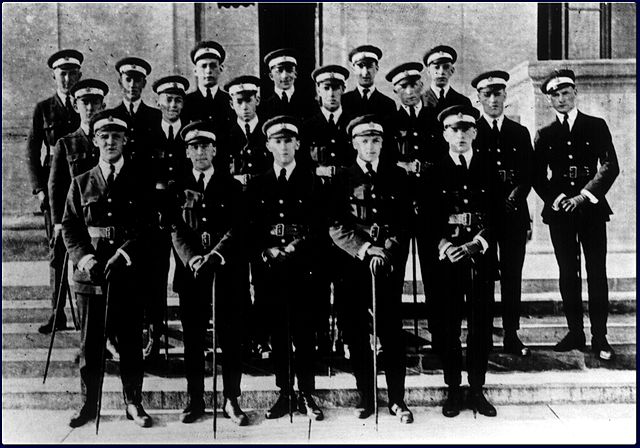
Cadets of the RCNAS in 1918.
———–
The interwar years
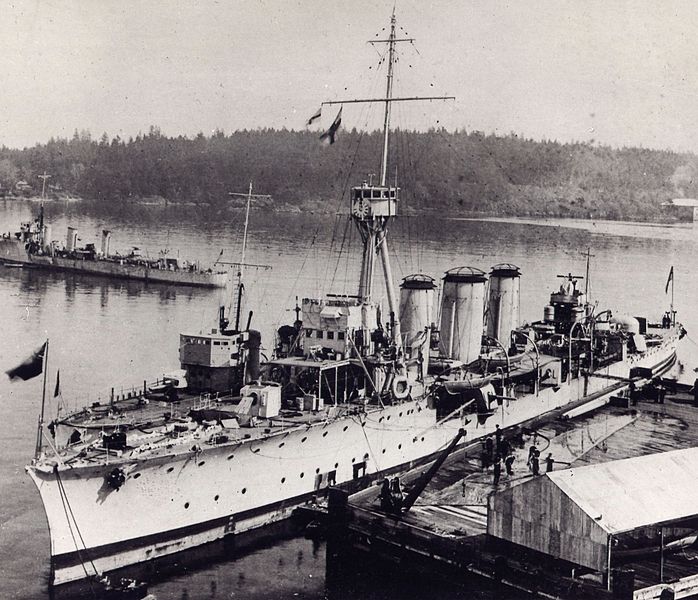
HMCS Aurora, discarded in 1921
An attempt to establish a viable postwar navy was thwarted by Prime Minister William Lyon Mackenzie King use of the 1923 Washington Naval Conference naval reduction as the excuse to curtail the naval budget. Subsequently, the director of the naval service closed the naval college and reduced the sstaff of the entire navy drastically. Resources left served to fund the creation of the Royal Canadian Naval Volunteer Reserve (RCNVR).
Therefore, the Navy has been retrograded to a very small force, only existing through civilian responsibilities of the Marine Service of the Department of Transport, with a crew of about 366 by 1922. The last cruiser, HMCS Aurora, was discarded. However soon the Royal Navy donated the destroyers HMCS Patriot and HMCS Patrician, used until the late 1920s and replaced by the HMCS Champlain and HMCS Vancouver, 1917 S-class destroyers. However an upgrade was soon organized: On 31 January 1923 was voted the creation of the Royal Canadian Naval Volunteer Reserve (RCNVR) with a personal of 1,000 from Twelve Canadian cities.
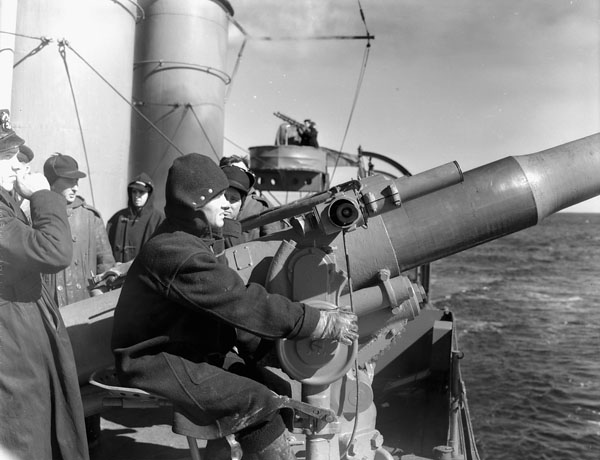
HMCS St.Croix 102 mm gunner training
In 1931 there was a real upgrade with the arrival of two modern ships, built at the origin for Canada: HMCS Saguenay and HMCS Skeena. Both would intervene during the El Salvador crisis in 1932, at the initiative of the president. The general state of the Navy was scarce, but this soon changed from 1935 with a rapprochement of views between Ottawa, London, Paris, and Washington about the rise of the Nazis and militarism of Japan and Italy.
After his re-election in 1935, Mackenzie King however started to change his attitude towards naval power in general came, appreciating the threat of a war between the United States and Japan, and boots rumble in Germany. However he only called for a modest expansion of the destroyer fleet, to make neutrality patrols in Canadian waters.
The Royal Navy soon sent two more modern destroyers, HMCS Ottawa and HMCS Restigouche of the same River class, while a custom-built training vessel was inaugurated, the tern schooner HMCS Venture, modelled after the famous bluenose, the legendary schooner of the region (1938) for training. So in September 1939, the RCN had six enlisted destroyers, among which two were modern and long-range, but also five minesweepers and two training vessels. The RCN boasted then a small but efficient fleet of a half-dozen destroyers and four modern minesweepers with a trained core of 3,500 regular and reserve sailors on which the Navy can expand by more acquisitions.
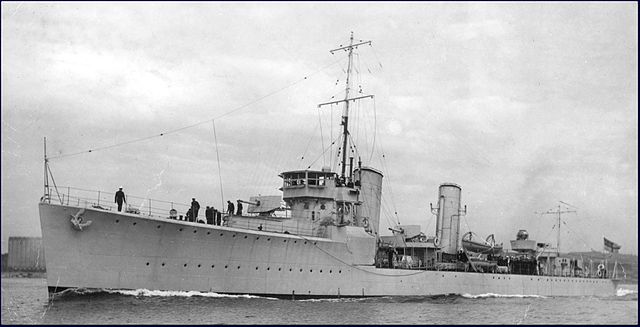
Destroyer HMCS Champlain, of the River class circa 1932.
World war Two
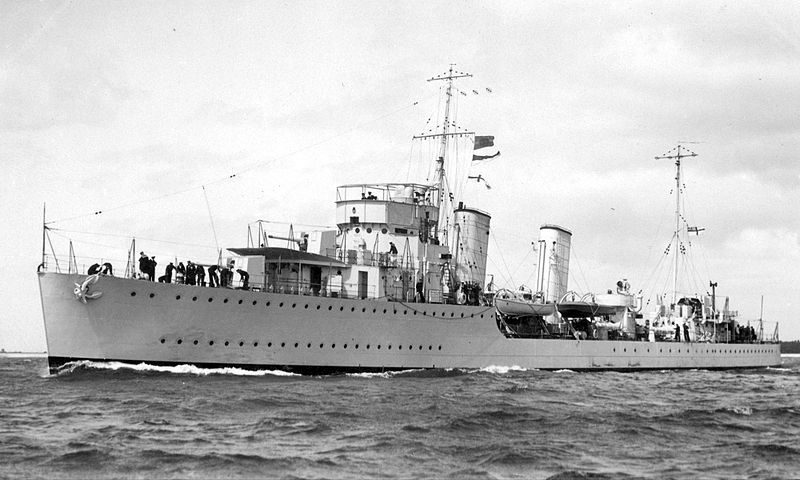
On the long run, Canada would grow to the world’s fourth largest fleet, a task made easier by the near-disappearance by 1943 of the Italian, German and Soviet navies and severe reduction of the IJN. In September 1945, The RCN ranked just behind the Royal Navy and US Navy. This considerable effort was made through local constructions (River and Flower class ships or Bangor-type minesweepers) but also many acquisition from the Royal Navy, including large vessels such as the Cruisers Uganda and Ontario at the end of the war, or even manning two leased aicraft carriers of the Bogue class.
Both British and Canadian authorities however believed in 1939 that the RCN could expand modestly, and be self-restrained to operations along the North American coastline and territorial waters. However in early 1940, already, the RCN was the first Canadian force in action -of all arms-. Orders were placed for the construction of 92 small warships throughout the conflicts, frigates, corvettes and minesweepers.
Additional destroyers came from the UK but five were also built locally (Iroquois or “Tribal” class). The rather slow and simple frigates and corvettes, made in civilian yards were only allowed by Canada’s limited shipbuilding capability, but they proved up to the task when adequately patrolling the entrance to ports, and coastal routes. They hunted down submarines and most of them were sunk by submarines, although statistic shows they were very few losses.
Ships Transfers
As the war broke out it was evident German ambitions in the Atlantic, evident right from the start, was something to be dealt with by Canada, and gradually the RCN was massively reinforced by US and British navies.
The first step of transfers was the Destroyers for Bases Agreement signed between the US and UK in September 2, 1940, later replaced by the Lend-Lease program. Signed with UK it also concerned Dominions, including Canada. The transfer terms concerned 50 ex-USN destroyers (the famous “four-pipers” of the Caldwell, Wickes, and Clemson classes).
This also concerned for Canada the following ships:
– USS Williams (DD-108), renamed HMCS St. Clair
– USS Yarnall (DD-143) Renamed HMS Lincoln and transferred in 1942 as HMCS Lincoln.
– USS Thatcher (DD-162) as HMCS Niagara
– USS Kalk (DD-170) as HMCS Hamilton
– USS Mackenzie (DD-175) as HMCS Annapolis
– USS McCook (DD-252) as HMCS St. Croix
– USS Bancroft (DD-256) as HMCS St. Francis
– USS Edwards (DD-265) HMS Buxton then transferred 1943 as HMCS Buxton
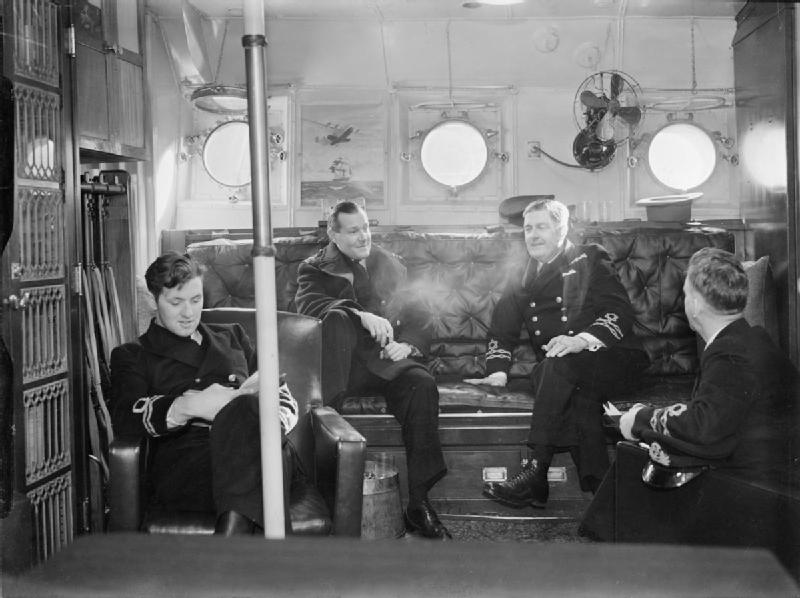
Inverted Lend-Lease
Canada created its own version of lend-lease for Britain, procuring considerable assets from its industries and products. This totalled $3.5 billion during the war together with a zero-interest loan of $1 billion. This was used by Britain to purchase Canadian food and war supplies. Another loan of $1.2 billion was made immediately after the war, fully repaid in late 2006.
Gander International Airport (1936) of Newfoundland was also leased by Britain for 99 years, for the transit of US- and Canadian built fighter and bomber aircraft to the old world. The deal also included the transfer of some Canadian-built ships…
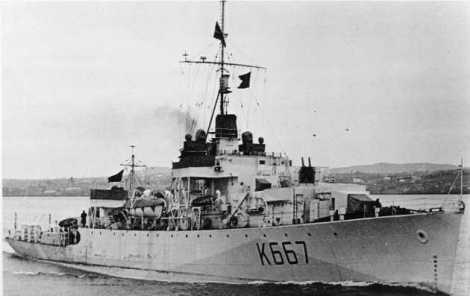
Massive construction plan
The plan concerned ASW ships which only required limited military expertise, mainly corvettes and frigates like the famous Flower and Rover classes. The only major ships of this fleet were from 1943 the light cruisers HMCS Uganda and HMCS Ontario (Crown Colony class).
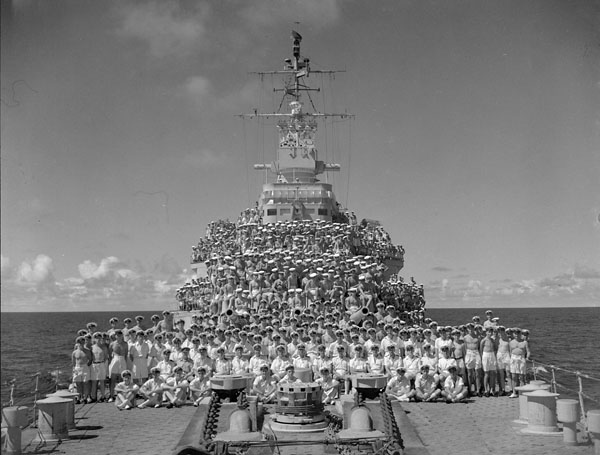
Operations of the RCN during WW2
1940 evacuations post-Dukirk
It is often forgotten but the collapse of the western front and evacuation of Dunkirk was followed by several other evacuations along the French coast, in other locations. The Canadian Navy participated in these and returned to their previous Convoy escort work in the North Atlantic.
Difficult Convoy escorts 1941-42
After the French and low countries defeat and occupation, the whole western coast of Europe, up to the northern hemisphere in Norway, hosted the Germany Navy. U-Boats became quickly the preferred way to wage warfare, and was deadly efficient in 1941. The crippling losses were not only related to civilian tonnage, but major warships as well.
Despite its small size, the Kriegsmarine developed a considerable nuisance capacity; Soon Canada will increase its participation, providing convoy escort up to the mid-Atlantic and in territorial waters.
Canadian implication became vital in 1941 as the USN was not yet committed, and Canadian ships started to operate in the Western Atlantic as well, and to be more active for ASW warfare.
It soon became clear that between old WW1-vintage flush-deckers retro-ceded by the Royal Navy and new and only partly equipped corvettes, with crews made of former merchant seamen as raw recruits were a poor start. To be effective, the RCN would need to spend greater resources and energy, time to become fully effective.
The mass of new ships flowing into the convoy system and old vessels in need of constant care had to be attended to in Halifax or even Sydney, Saint John, Pictou, and many locations already busy and under-manned, under-equipped to face repair work for merchant vessels alone. The Halifax base had in addition the burden of training crews and equipping the new ships emerging from from small shipyards along the St. Lawrence river and the Great Lakes. The old Royal Navy dockyard was soon swamped with temporary constructions, and the navy was force to make other requisitions over adjacent army and municipal properties, soon overcrowded as well.
Desperate after the crippling losses in the middle Atlantic, the weakest point of the allied defences, made the Royal Navy crying for help to Canada in May 1941. Canada responded by establishing a new naval base at St John’s, Newfoundland, supplying warships escorting convoys across 3,000 kilometres of ocean between Newfoundland and the British Isles. Canadian warships operating in British waters came to Newfoundland to provided this much-needed cover of the “gap”. Corvettes hastily completed in Canadian shipyards struggled with untrained crews but at least were present at any stage. Smaller ships (Like the Fairmile C) designed for calm coastal waters, also manned by inexperienced sailors faced harrowing enemy attacks in these unforgiving, stormy open ocean waters.
RCN’s breaking point
At the end of 1941, senior officers’s reports alarmingly told about men and ships tested beyond their limits. Equipment was scarce and insufficient in quantity and quality or inadequate, insufficient training. In addition at that time there was no recognition of PTD, allowing exhausted men to recover from what they routinely witnessed, ships blown apart and people jumping at sea burning alive, or survivors freezing to death. Yet there was no respite, even after the United States entered the fray, as the fleet was busy in the Pacific. At the same type U-Boats started their unrestricted rampage on the North American coast with new long-range U-Boats.
In January 1942 eight U-boats came close to southern Newfoundland and Nova Scotia, and started torpedoing ships on sights. However, canada, already trained by the RN to convoy escort answered quickly, effectively, and the Germans soon had to divert on the less defended US coast. U-boats however were maintained on station in Canadian and Newfoundland waters all along 1942. They used clever tactics to turn over Canadian defences, seeking targets of opportunity, and claiming 70 vessels. At that time 21 were lost in the Gulf of St Lawrence itself. The deep, turbulent waters also contributed to the U-Boats escaping detection.
The United States became the main source of supplies for Britain and in the summer of 1942, HX convoys shifted to New York. The could still not provide an adequate escort at that point so the task of defending these convoys fell on Halifax-based Canadian warships, on the sea lane between New York and Newfoundland and back. These were additional tasks for an already overburdened Navy while still being a major part of the mid-ocean escort force between Newfoundland and British waters. Whereas in the summer and autumn of 1942, the German “wolfpack” offensive became even stronger than in 1941.
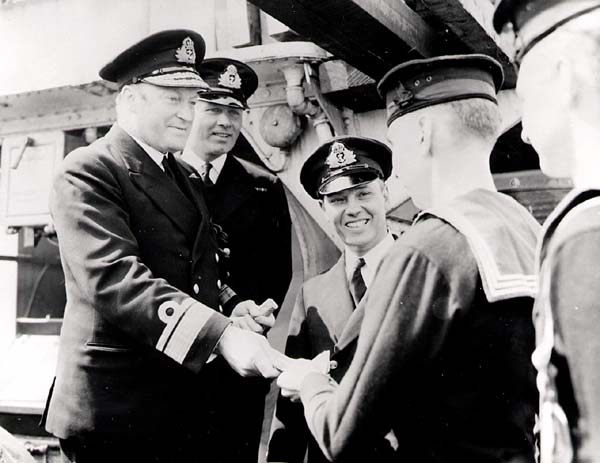
Admiral L.W. Murry, Newfoundland Command
1943 return
in early 1943, Canada’s battered mid-ocean escort groups were relocated to British waters, leaving place to the brand new crack British submarine-hunting support groups against the wolfpacks. They will gave excellent results. Meanwhile the RCN started to recuperate and received not only new ships but also new detection and weaponry provided by the more advance Royal Navy. However this respite was short. As soon as it was prepared, Canadian ships went on the difficult UK-Gibraltar convoy lane. As soon as they were spent on this sectors, packs of ships returend to the north Atlantic, covering this time the dreaded “western approaches”.
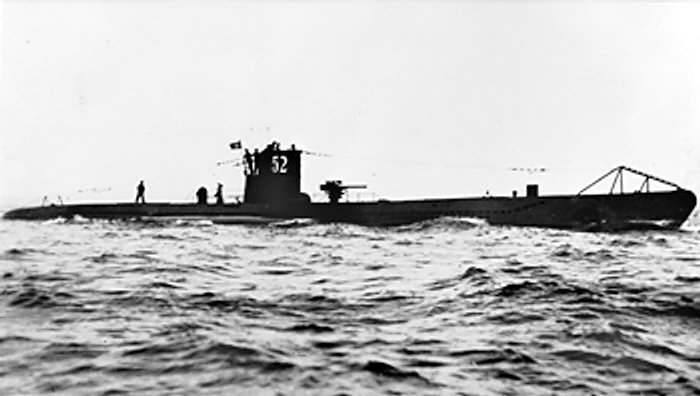
U-52, one of the long range U-boats operating off the coast of Canada and the St Lawrence river.
The Combined British-Canadian effort started to brought down Karl Dönitz offensive to a standstill, and beyond. U-Boats losses amounted to such as level that the German admiral pulled his forces out of the central north Atlantic by May 1943, until then his free hunting ground. However there were still 200 U-boats able to go at sea, using new training, equipment and tactics. At last, Canada’s large naval contribution was acknowledged. Soon the Canadian and Newfoundland waters became a purely Canadian affair, separated from the Atlantic command. Until the, an American admiral based in Newfoundland directed the defense operations. He was replaced by Rear-Admiral L.W. Murray, which funded in Halifax the Canadian Northwest Atlantic headquarters on 30 April 1943.
Dramatic expansion
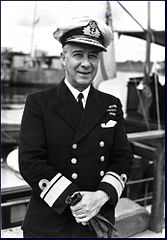 Soon after the RCN started a thirtyfold expansion up to 96,000 sailors of all ranks (plus 6,500 women in many services). This of course has been obtain after the reopening of the naval college. However Canada in 1942 and 1943 tried to have ever larger numbers of ships to sea, not fully combat effective. This conducted to an equipment and training crisis in the spring of 1943 which provoked the dismissal of the chief of naval staff, Vice Admiral Percy Nelles.
Soon after the RCN started a thirtyfold expansion up to 96,000 sailors of all ranks (plus 6,500 women in many services). This of course has been obtain after the reopening of the naval college. However Canada in 1942 and 1943 tried to have ever larger numbers of ships to sea, not fully combat effective. This conducted to an equipment and training crisis in the spring of 1943 which provoked the dismissal of the chief of naval staff, Vice Admiral Percy Nelles.
The years 1944-45
The scope of Canadian operations raised dramatically as the moment when the fleet was expanding the same: Canadian ships participated routinely on the difficult, treacherous Murmansk Run. They were enough to patrolled the English Channel in support of the D-Day landings while Canadian minesweepers cleared the approaches to the Normandy beaches. Ad of course at D-Day, Canadian landing ships took part. Canadian cruisers and destroyers participated in the assaults on the Aleutian Islands, Sicily, Italy, southern France, Greece, and even after the fall of the Reich, the liberation of Hong Kong.
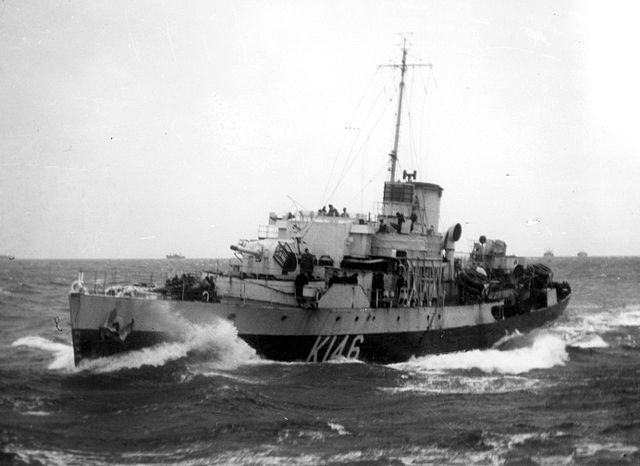
HMCS Pictou
In fact, both 1944-45 Canadian cruisers joined the British Pacific fleet, supporting operations against Japanese home islands. At that time, total strength of the Navy was more than 400 warships. In September 1945, statistics showed than the RCN destroyed 42 enemy vessels, and 33 submarines, sometimes in coordination with aviation. This was paid by the loss of of 30 ships and 1,990 fatalities and in addition, Canadian sailors served with distinction on capital ships, cruisers, and aircraft carriers in the Royal Navy. The heaviest losses occured in late 1944 and 1945, righ up to a few day before V-Day in the Atlantic, due to snorkel-equipped U-boats, new evasion tactics, and new guided torpedoes, like HMCS Shawinigan, HMCS Claycquot, and HMCS Esquimalt.
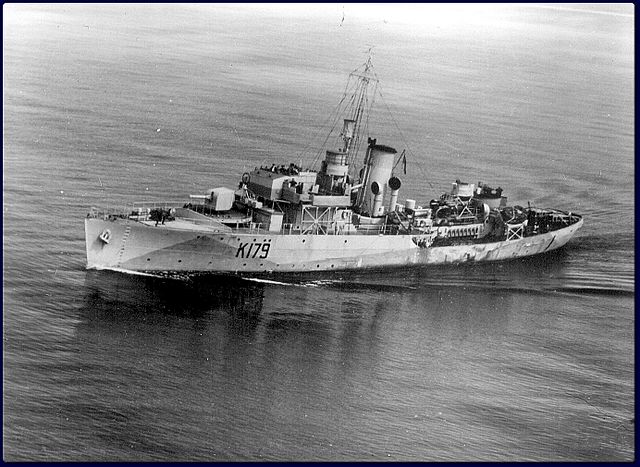
HMCS Buctouche
The commitment to the Battle of the Atlantic at some point included some 270 ocean escort warships, making it at some point late in the war, the third-largest navy in the world, allowing the safe passage during the war of over 25,000 merchant ships. These delivered near to 165 million tons of supplies to the United Kingdom and Allied forces liberating Europe.
During these operations the RCN lost eight ships to collisions and accidents in the difficult north Atlantic with 2,000 members of the RCN who loosing their lives. Compared to U-Boat loss, this was about the same on board German submarines. However proportionally, Canadian merchant seamen lost one in ten on a total of about 12,000 who served in the Allied merchant fleet at large.
———–
Read More/Src
veterans.gc.ca royal-canadian-navy
warmuseum.ca battle-of-the-atlantic-1939-1945
thecanadianencyclopedia.ca
Conway’s All the World’s Fighting Ships 1922–1946.
Syrett, David (1994). The Defeat of the German U-boats: The Battle of the Atlantic
William R. Casto, “Advising Presidents: Robert Jackson and the Destroyers-For-Bases Deal.” American Journal of Legal History
Blair, Clay (1996). Hitler’s U-Boat War, The Hunters 1939-1942. Random House
United States Treaties and Other International Agreements, Volume 23, Part 4
Macpherson- The Ships of Canada’s Naval Forces 1910–2002 (Third ed.). St. Catharines, Ontario: Vanwell Publishing
Macpherson, Ken; Barrie, Ron (2002). The Ships of Canada’s Naval Forces 1910–2002
Canadian War Museum, Democracy at War: Canadian Newspapers and the Second World War, The Battle of the Atlantic
Alan Easton, 50 North: An Atlantic Battleground, Toronto, Ryerson, 1963.
Michael Hadley, U-Boats Against Canada, Montreal, McGill-Queen’s University Press, 1985.
Marc Milner, North Atlantic Run: The Royal Canadian Navy and the Battle for the Convoys, University of Toronto Press, 1985.
Marc Milner, The U-Boat Hunters, University of Toronto Press, 1994.
Roger Sarty, Canada and the Battle of the Atlantic, Montreal, Art Global, 1998.
Joseph Schull, The Far Distant Ships, Ottawa, King’s Printer, 1950.
G.N. Tucker, The Naval Service of Canada, Volume II, Ottawa, King’s Printer, 1952.
wikipedia.org/wiki/List_of_Royal_Canadian_Navy_ships_of_the_Second_World_War
wikipedia.org/wiki/List_of_ships_of_the_Royal_Canadian_Navy
wikipedia.org/wiki/History_of_the_Royal_Canadian_Navy
Video: Archive footage
THE FIGHTING SEA FLEAS – Motor Torpedo Boats , WWII , Battle of the Atlantic , PT Boats 20130
Video: WW2 American footage documentary about the WW2 canadian Navy.
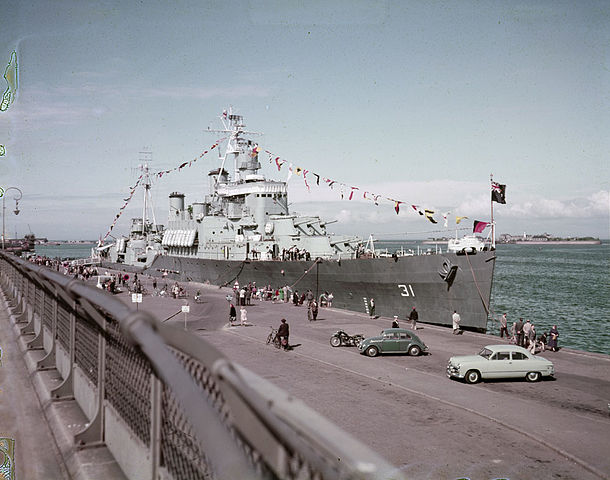
HMCS Quebec at Stockholm in 1954, during the Korean War.
Ships of the RCN during WW2
A brief overlook on the composition of the fleet in 1945 (see the poster) shows quite clearly a large provision of light ships, ASW Frigates, corvettes and versatile minesweepers. That was certainly less glamour than the scores of battleships and aircraft carriers deployed by the other allies, but this humble yet very busy Canadian fleet greatly helped turning the tide of the battle of the Atlantic. Without it, there would have be no return of the situation in 1944, no win in Africa nor offensive in Sicily and Italy later. No D-Day and without lend-lease or diversion front USSR would have probably collapsed.
Aircraft Carriers

Technically the HMS Nabob and HMS Puncher of the Ruler class escort aircraft carriers of the Attacker class, based on the Type C3 design. Although they have been acquired and operated at first by the Royal Navy upon completion and transfer, the RCN asked the permission to train personal on board, which was granted, while the HMS Puncher was directly manned by Canadian personal. However both were listed in the Royal Navy in the strict sense. HMS Nabob was torpedoed 22 August 1944, by U-354 (O/L Hans-Juergen Sthamer) west of the North Cape, the only carrier of the class to be sunk in action.
However there were plans to transfer major fleet aircraft carriers to Canada at the end of the war. This planned transfer of the HMCS Warrior and HMCS Magnificent of the 1942 Design Light Fleet Carrier was slowed, and Warrior was soon found to be unsuitable for the North Atlantic winter. This was discovered between the years 1948-57 when she was loaned to the RCN. HMCS Magnificent was not transferred at first for the same reasons. Magnificent was returned to the Royal Navy whereas in the cold war Canadian Navy would obtain another ex-British carrier for cheap, as UK was bankrupt. This was the HMCS Bonaventure, former HMS Powerful. She arrived in 1952 and served until July 1970, the last Canadian aircraft carrier as well.
Cruisers
Uganda
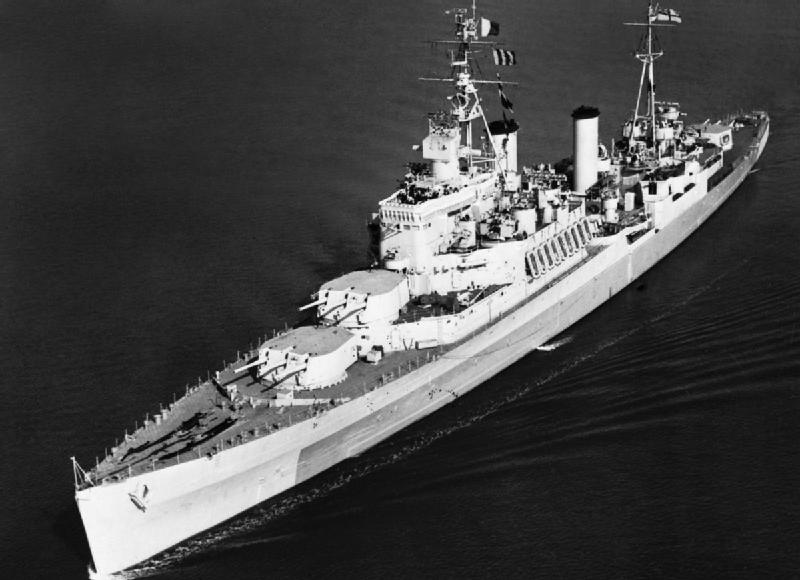
First modern cruiser adopted by Canada since 1920, 23 years prior with the HMCS Aurora discarded. This was one of the Crown Colony class cruisers, modernized and simplified version of the 1936 “Town” class. This was the reduced 8000 ton design after the London conference, therefore more compact. But the main armament remained the same, a battery of twelve rapid-fire 6-in BL Mk XXIII guns, completed by eight (4×2) 102 mm/45 QF Mk XVI guns, while the AA armament comprised three quadruple 40/39 2pdr QF Mk VIII mounts, twenty 20mm/70 Oerlikon AA guns and two triple TT banks and two aircraft (variable type for reconnaissance).
Its electronics suite was made of a type 272, type 281, type 284, and type 285 radars in 1944 as modernized. The HMCS Uganda was modernized once again in the 1950s, with a new electronics suite and one less turret replaced by a new automated AA artillery. The ship became the HMCS Quebec and served until June 1956.
Ontario
Built in Harland & Wolff and launched 29 July 1943, she was originally HMS Minotaur, first improved Fiji class cruiser, of the Minotaur class, of which three were completed in 1944 whereas nine were ordered. She was renamed and transferred before her completion as HMCS Ontario in 25/05/1945. The class was deprived of a triple 6-in turret for more AA. She has the same close-range outfit as Swiftsure, six 40 mm and six 20 mm guns at the end of the war in single mountings. She was decommissioned on 15 October 1958.
Destroyers
The fleet of Canadian destroyers was fairly large by 1945: Nine classes of destroyers, about 60 ships.
SAGUENAY class destroyers (1931)

The Saguenay (D79) and Skeena (D59) were launched in 1930 at Thornycroft, Woolston, as extras of the A and B classes. They were transferred upon completion in 1931 to the RCN. Specs as for the British A-B class. Modernization includes four 533 TTs, 2 DCR; + one 76/45 20cwt QF Mk I/II/III/IV, 2 DCT (20 – 40 DC totally) and a type 128 sonar in 1940, later a 120mm/45 and 2 DCT (70 DC total), two 20/70 Oerlikon Mk II/IV and in 1942 two 40mm/39 bofors and two 20mm/70 Oerlikon Mk II/IV, plus 125 deep charges. Saguenay received a type 271, type 286 or type 291 radars in 1942 nd Skeena a SW1C radar in addition and in 1944 a single 120mm/45, a type 128 sonar two additional 20mm/70 Oerlikon Mk II/IV, one 24 tubes Hedgehog Mk 10 ASWRL assisted by a type 144 sonar.
HMCS Saguenay was one of the rare Canadian destroyers to be torpedoed by an Italian submarine in the Atlantic, the Argo (Dec. 1940). She survived, only to be damaged in 1942 in a collision with SS Azara off Newfoundland. Almost a total constructive loss she was only partially repaired to serve as a moored training ship. HMCS Skeena was Skeena wrecked in a mist in Hval-fjord 25/10/1944.
It should be noted that both ships differed from the usual A/B class, tailored for Canadian service: They were strengthened for ice navigation, and wider to manage 50-60t of ice without risk for stability and the superstructure was better covered.
FRASER class destroyers (1931-1937)
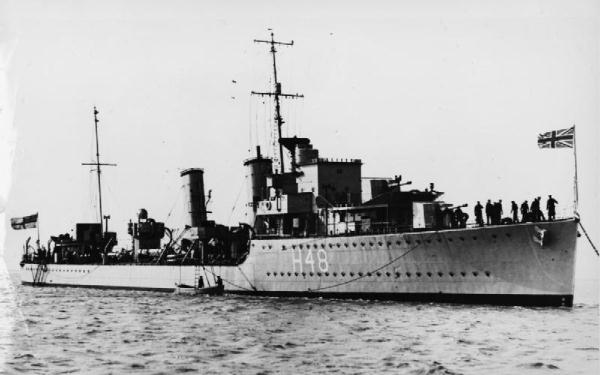
They were C and D class destroyers built in Vickers-Armstrong (Barrow), Portsmouth DYd, White (Cowes), Palmers (Jarrow), and Thornycroft (Woolston). Of the “C” group, they were the HMCS Fraser (ex-Crescent), St. Laurent (ex-Cygnet), Restigouche (ex-Comet), Ottawa (ex-Crusader), Assiniboine (ex-Kempenfelt) and for the “D” group, Margaree (ex-Diana) and Kootenay (ex-Decoy). Compared to the previous classes they had a better AA and fire control system, increased displacement and better machinery rated for 36 000 hp, larger superstructure.
The first five were transferred to the RCN in 1937-39 and the last two in 1940 and 1943.
HMCS Fraser collided with cruiser Calcutta on 28/6/1940 in the mouth of Gironde (SW France) while Ottawa was sunk by German submarine U91 off the Canadian coast 14/9/1942. HMCS Margaree collided with s/s Port Fairy in the Northern Atlantic on 22/10/1940 and sank. HMCS Assiniboine was foundered and wrecked at Prince William Island on 10 November 1945.
 MONTGOMERY & St.Croix class destroyers (1918-1919)
MONTGOMERY & St.Croix class destroyers (1918-1919)
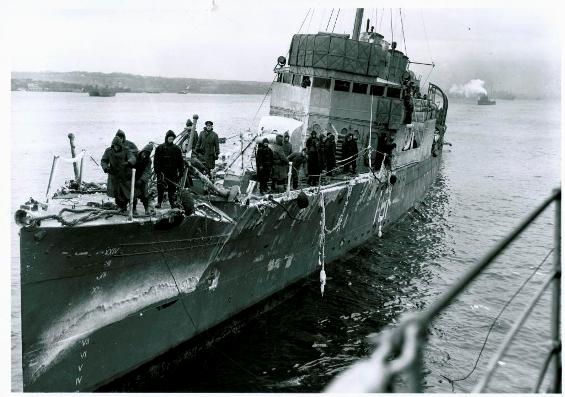
Damaged HMCS St Croix after a storm
Fifteen lend-lease “four pipers” transferred to the Royal Navy and later to the RCN as HMCS Annapolis, Caldwell, Chelsea, Columbia, Georgetown, Hamilton, Lancaster, Leamington, Mansfield, Montgomery, Niagara, Richmond, St. Clair and Salisbury. They were fitted with British sonars the aft 102 mm gun was replaced by a British 3-in AA, TT mounts and another 102 mm were removed and 4 DCTs installed at the stern. HMCS Columbia was damaged on 25/2/1944, never repaired and stricken in 1945, the other survived. The three St. Croix class (Buxton, St Croix, St Francis) were transferred in 1940. St. Croix was sunk by German submarine U305 off South Iceland 20/9/1943. St. Francis was sunk 14/7/1945 after colliding with s/s Winding Gulf off Rhode Island.
 SAGUENAY class destroyers (1930)
SAGUENAY class destroyers (1930)

These two Canadian destroyers, HMCS Saguenay and Skeena, buiult by Thornycroft (at Woolston, Hampshire) were designed along the A-class to tactically combine with them in wartime. The hull was different in that more flare was added to their bow to make them drier and the forward hull reinforced to support icing in winter. Their metacentric height was also increased forthe same reason, incorporate the build-up of ice and snow, so they were for this reason feet (0.9 m) shorter. These were well-though vessels, with better heating provided. They also had an extra 50 long tons of fuel, to cope with heavy weather, but 2,000 shp (1,500 kW) fewer horsepower. They also lacked superheaters for their boilers but on paper kept the same range and speed. They also had Thornycroft’s signature broad, slab-sided funnels. The other name they were known for was River class. But in reality these fourteen destroyers of the Royal Canadian Navy only shared the fact to be named after Canadian rivers, all purchased from the Royal Navy and tow built specifically by British yards as beyond the A class, there five C class, two D class, one E class, two F class, one G class and one H class. But HMCS Saguenay and HMCS Skeena were the first specifically built for the RCN.
 IROQUOIS class destroyers (1942)
IROQUOIS class destroyers (1942)
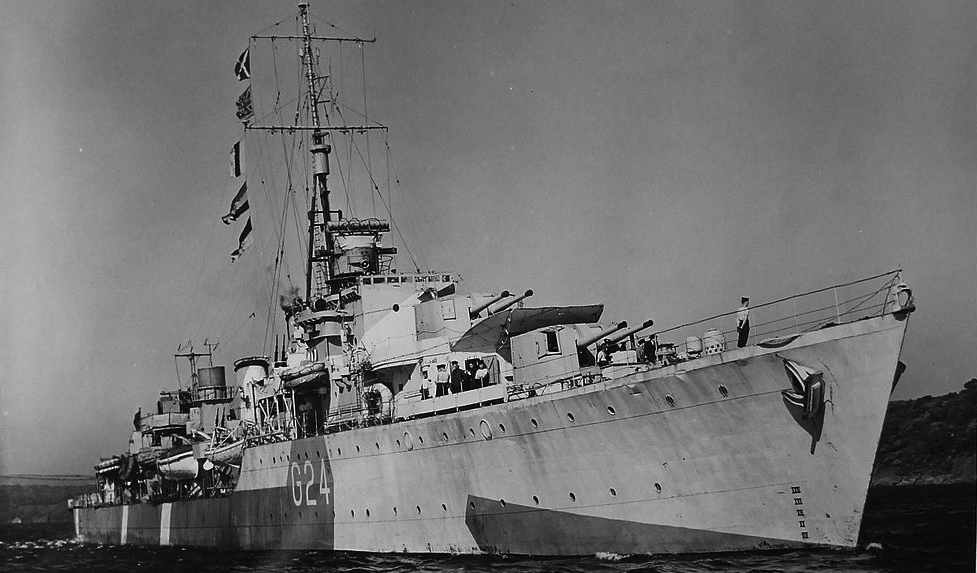
HMCS Athabaskan, Haida, Huron, Iroquois, Cayuga, Micmac and Nootka. They were “Tribal” class vessels were heavy destroyers with ten guns in five twin 102mm mounts. The Tribal class was slightly larger, with a clipper bow than usual destroyers, had 30% more engine power, but retained the same internal arrangement and the same cross-section hull framing system.
The biggest difference was their armament, which was nominally a very large increase in firepower, sacrificing one torpedo tubes bank. The usual provision was four twin 102 mm guns and two quadruple 40mm pompoms. Variants saw an increase of AA artillery and the sacrifice of one turret. Twin turrets was also highly unusual at that point, but the ‘Tribals’ which production started before the war in 1937, went in the Empire, plans being sent to Australia and Canada to built their own ships. *Australia built the Arunta, Bataan, Warramunga at Cockatoo.
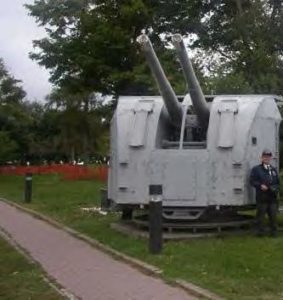 To the exception of Athabaskan (II), Cayuga, Micmac, Nootka which had four twin 102/45 QF Mk XIX guns, the others were armed with three turrets armed with the 120/45 QF Mk XII and one with the 102/45 QF Mk XVI. AA provision was one or two quad 40 mm Bofors, and twenty 20 mm Oerlikon guns.
To the exception of Athabaskan (II), Cayuga, Micmac, Nootka which had four twin 102/45 QF Mk XIX guns, the others were armed with three turrets armed with the 120/45 QF Mk XII and one with the 102/45 QF Mk XVI. AA provision was one or two quad 40 mm Bofors, and twenty 20 mm Oerlikon guns.

HMCS Iroquois in 1944
Their more successful arrangement of quadruple pompom were their only real difference with British ships.
Typical electronics suite was a type 262, type 268, type 275, type 277, and type 291 radars, and type 144 sonar. They were the last “Tribals” of the war, built in part at Vickers-Armstrong on the Tyne, and the remainder in Halifax, launched 1941-42 while the last Halifax ships were launched in 1944-46, not taking part in wartime operations. They would serve until the 1960s. HMCS Athabaskan (I) was sunk on 29.4.1944 by the German TB T24 near Ile de Bras, British channel. HMCS Haida was preserved an can be visited today at Toronto.
 GATINEAU class destroyers (1935)
GATINEAU class destroyers (1935)
Three destroyers, one of the ‘E’ type, HMCS Gatineau (ex-Express), and HMCS Saskatchewan (ex-Fortune) and Qu’Appelle (ex-Foxhound) of the ‘F’ type. The main difference from the C-D types were the sectioning of 2nd boiler room by a watertight bulkhead on two smaller ones, therefore three boilers to prevent damage. Qu’Appelle had two 20/70; two twin 20/70 Oerlikon Mk II/IV, and two twelve 178 dual Hedgehog Mk II ASWRL. They were transferred and renamed in 1943-44. They survived the war, having no particular event.
 OTTAWA class destroyers (1936)
OTTAWA class destroyers (1936)
Two destroyers, one of the ‘G’ group (HMCS Ottawa) and one of the ‘H’ group, HCM Chaudiere. They were virtually repeats of the “Е” class but with a different machinery arrangement and slightly lighter displacement. The first has a 36 000 to 34 000 hp power reduction, they had also a tripod main mast. The new Mk XVII main gun mounts of the ‘H’ class had a 40° elevation. Chaudiere (transferred in November 1943) was armed with a single 24 – 178 Hedgehog ASWRL and a single 120/45 QF Mk IX.
 ALGONQUIN class destroyers (1944)
ALGONQUIN class destroyers (1944)
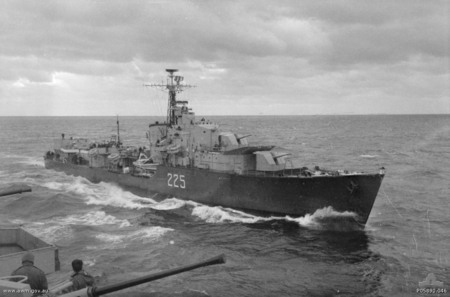
HMCS Sioux
The class comprised the Algonquin, built at John Brown, Clydebank, launched 2/9/1943, completed in February 1944, and the HMCS Sioux, used the
type 276, type 285, type 291 radars and type 144 sonar. They were ships of “S” class, ordered in 1941. They had the new twin 40mm Bofors-Hazemayer MG with electronic, radar-guided fire control, and the new twin 120mm/45c capable of a 55° elevation.
The latter was discarded in 1965 but the Algonquin was modernized as an ASW frigate, rebuilt in 1953 as a type 15 frigate. After reconstruction she gained a new silhouette with an enlarged forecastle and made in aluminium alloy. She was discarded in 1971.
 CRESCENT class destroyers (1945)
CRESCENT class destroyers (1945)
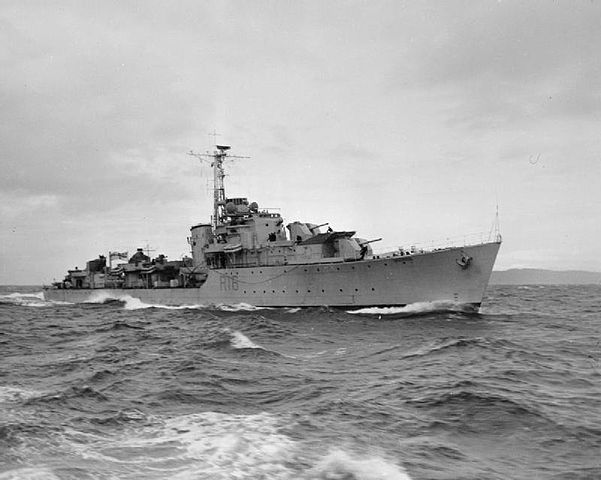
HMCS Crescent (R16)
Crescent and Crusader were built at John Brown, Clydebank, as “Ca” type ships, using the new DP fire control system (‘Battle’ class), and just one TT bank. They were the first all-welded destroyers in the Royal Navy; They were completed in September and November 1945 respectively and therefore saw little of the war. Crescent was rebuilt in 1953 as a Type 15 Frigate and discarded in 1971, Crusader was discarded in 1965. They were not the last Canadian destroyers, as the Iroquois class built in 1971 was the last, as helicopter ships.
————-
Frigates
 Canadian RIVER class (1942-43)
Canadian RIVER class (1942-43)
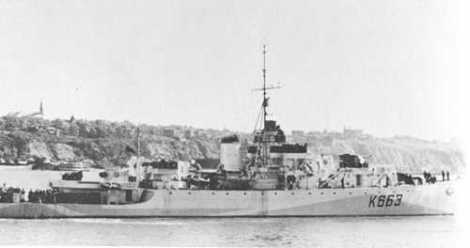
HMCS Cap de la Madeleine
They were a mix of early River Type, built in UK and in Canada. The British built units were the HMCS Annan, Ettrick, Meon, Monnow, Nene, Ribble and Teme. The Canadian built were the Annan, Cape Breton, Dunver, Grou, Matane (ex-Stormont), Montreal, New Glasgow, New Waterford, Outremont, Port Colborne, Prince Rupert, St. Catherine, St. John, Stormont, Swansea, Valleyfield, Waskesiu and Wentworth.
The British-built ships had a minesweeping equipment, however on the Canadian ships fuel storage was augmented from 440 to 464 tons of oil. The British built ships had a type 271/272, a type 291 or type 277 radar, and a type 144 sonar, while the Canadian ones, had a SU radar and a type 144 sonar. Typically they had two 102/40 QF Mk XIX guns and four to six 20/70 Oerlikon Mk II/IV guns and a single 24 – 178 Hedgehog ASWRL plus eight Depth Charges Throwers, and two DC racks (126 – 150 DC total in storage). HMCS Annan from Canadian Vickers, Montreal, was transferred before completion to the USA on 11/1942 as USS Natchez. She was used to test the British Frigate concept. HMCS Valleyfield was the only sunk, on 7/5/1944.
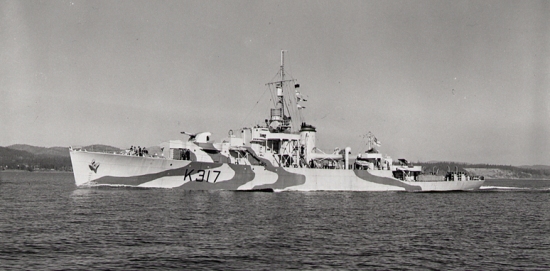
HMCS Chebogue
There was a second generation of River class Frigate (‘late type’) were all built in various Canadian yards: Canadian Yarrow (Esquimalt), Davie SB (Lauzon), Morton (Quebec City). They were the Alexandria, Antigonish, Beacon Hill, Buckingham, Cap de la Madeleine, Capilano, Carlplace, Charlottetown, Chebogue, Coaticook, Eastview, Fort Erie, Foster, Glace Bay, Hallowell, Hardrock, Henryville, Inch Arran, Joliette, Jonquiere, Kirkland Lake, Kokanee, La Hulloise, Lanark, La Salle, Lauzon (ex-Glace Bay), Le Havre, Levis, Lingabar, Longueuil, Magog, Merrittonia, Northumberland, Orkney, Penetang, Pesaquid, Plessiville, Poundmaker, Prestonian (ex-Beauharnois), Ranney Falls, Royal Mount (ex-Alvington), Runnymede, St. Agathe, St. Edouard, St. Pierre, St. Romauld, St. Stephen, Ste. Therese, Sea Cliff (ex-Meganic), Shipton, Springhill, Stettler, Stonetown, Strathadam, Sussexvale, Thetford Mines, Tisdale, Toronto (ex-Giffard), Victoriaville, and Westbury. They were completed in 1944 but Foster, Hardrock, Henryville, Le Havre, Lingabar, Merrittonia, Northumberland, Pesaquid, Plessiville, Ranney Falls, St. Agathe, St. Edouard, St. Romauld, Shipton, Sussexvale, Tisdale and Westbury, Westville and Wulastock were cancelled. 17 ships were converted in 1953-59 as modern ASW frigates. The late River only counted wo losses: Chebogue, torpedoed 4/10/1944 by U1227 and HMCS Magog by U1223.
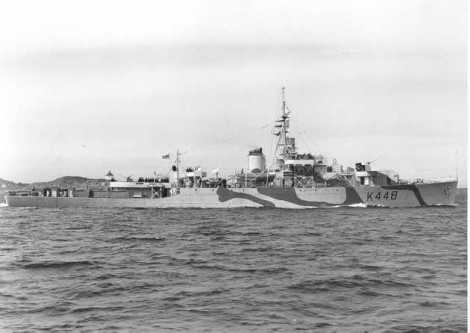
HMCS Orkney
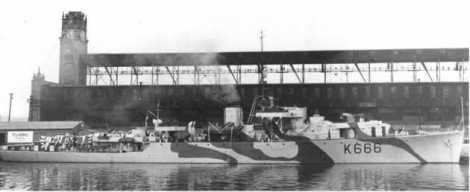
HMCS Hallowell
 Canadian LOCH class (1944)
Canadian LOCH class (1944)

Three ships were transferred to the RCN in 1944, Loch Achanalt (ex-Naver), Loch Alvie and Loch Morlich, completed in August 1944. The Loch class were simplified River class ships for mass-production. Modular pre-built sections made in inland plants were used for quick assembly. The longitudinal hull framing system and intensive welding were adopted. They only served for a few month and were transferred back to UK.
Corvettes
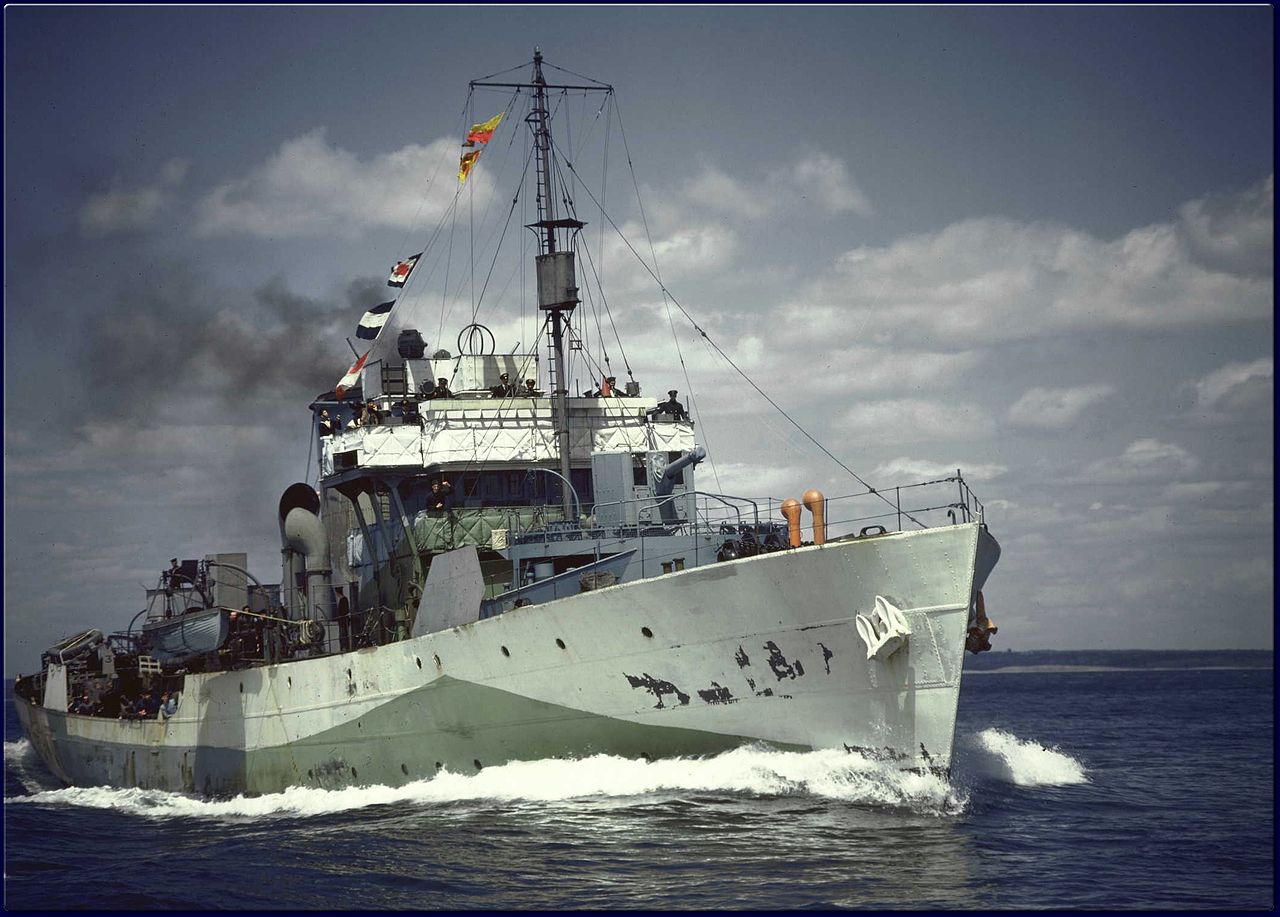
HMCS Regina, a Canadian-built flower class corvette (cc)

 Canadian Flower class (1940)
Canadian Flower class (1940)
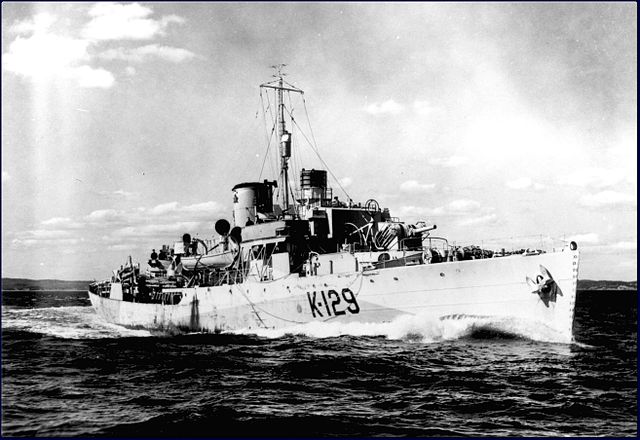
They were all built in Canadian yards along the 1939-1940 program. The Flower class were small vessels made in civilian specs, derived from a whaler design, lightly armed and slow, but well tailored for their ASW role. The class comprised the HMCS Brantford, Calgary, Charlottetown, Dundas, Fredericton, Halifax, Kitchener, La Malbaie, Midland, New Westminster, Port Arthur, Regina, Timmins, Vancouver, Ville de Quebec, Woodstock which were armed with one 102mm/45 BL Mk IX, one 40mm/39 2pdr QF Mk VIII, two 20mm/70 Oerlikon Mk II/IV, and one 24 – 178 Hedgehog ASWRL, 4 DCT, and 2 DCR with 70 deep charges in reserve.
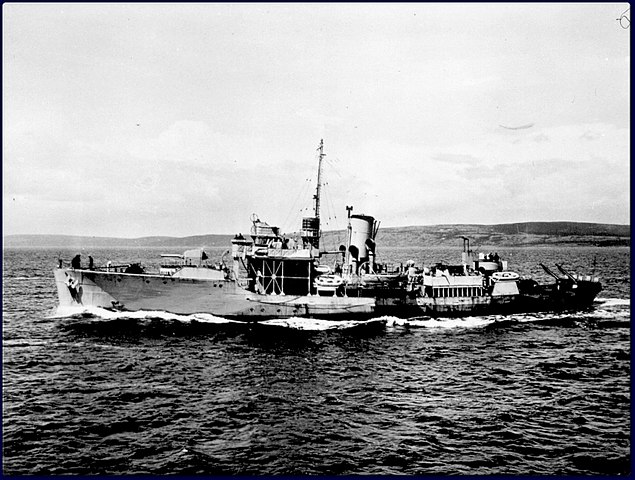
HMCS Alberni
The HMCS Agassiz, Alberni, Algoma, Amherst, Arvida, Arrowhead, Baddeck, Barrie, Battleford, Bittersweet, Brandon, Buctouche, Camrose, Chambly, Chicoutimi, Chilliwack, Cobalt, Collingwood, Dauphin, Dawson, Drumheller, Dunvegan, Edmundston, Eyebright, Fennel, Galt, Hepatica, Kamloops, Kamsack, Kenogami, Lethbridge, Levis, Louisburg, Lunenburg, Matapedia, Mayflower, Moncton, Moose Jaw, Morden, Nanaimo, Napanee, Oakville, Orillia, Pictou, Prescott, Quesnell, Rimouski, Rosthern, Sackville, Saskatoon, Shawinigan, Shediac, Sherbrooke, Snowberry, Sorel, Spikenard, Sudbury, Summerside, The Pas, Trail, Trillium, Wetaskiwin, Weyburn, Windflower were armed wth the same 102mm/45 BL Mk IX but for AA two 12.7/62 nstead of the 2-pdr, 2 DCT and 2 DCR. Electronics-wise they used a type 271 or for some ships, type 286 radars, and the type 123 sonar.
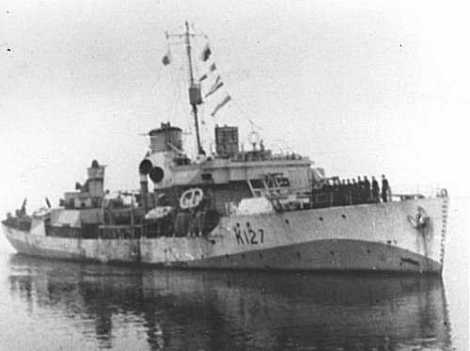
HMCS Algona
The Canadian “Flower” program started as a local production for the Royal Navy, when 10 ships were ordered, transferred to Canada before completion. The Canadians 70 more corvettes for the needs of the RCN, although the majority were extra equipped with a minesweeping equipment. They were launched in 1940-41 and completed in 1941, in a fairly short time on average.
By 1943-1945, survived ships had extra light AA armament, one 40mm/39 2pdr QF Mk VIII, two 20/70 Oerlikon Mk II/IV or three, four in alternative, or two twin mounts of the same. ASW armament always comprised the 24-tubes Hedgehog ASWRL, 4 DCT and 2 DCR with up to 72 deep charges in reserve.
There were a few losses, as the U72 Submarine sank the HMCS Levis (possibly also U552, 19/9/1941). HMCS Charlottetown was sank by U517 on 11/9/1942 and HMCS Shawinigan by U1228 on 25/11/1944. HMCS Weyburn hit mines and sank on 22/2/1943 and HMCS Regina was sunk by U667 on 8/8/1944 while HMCS Albernie was also sunk on 21/8/1944 and HMCS Louisburg was sank in the Mediterranean by an Italian air torpedo on 16/2/1943.
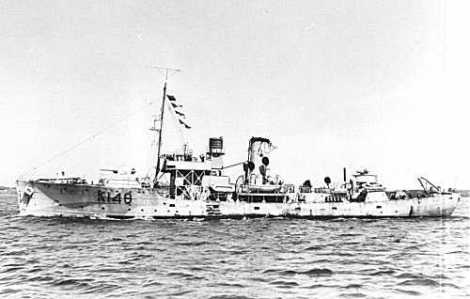
HMCS Amherst
 Improved Flower class (1943)
Improved Flower class (1943)
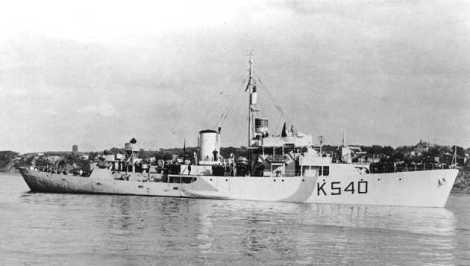
About 27 of these improved models were built with considerably increased fuel stowage, as the main criticism of previous type was the lack of range. They were laid down in 1942-43, launched in 1943 and completed in 1944 for the most. About half were built at Ferguson (Glasgow), Hall (Aberdeen), Crown (Sunderland), or Inglis, Glasgow. Canadian ships were from yards such as Collingwood SY, Kingston SY, Midland SY, and Morton, Quebec City.
British ships of the 1941 program were the Forrest Hill (ex-Ceanothus), Giffard and Mimico (ex-Bulrush). From the 1942 program, HMCS Long Branch was built in UK and the remainder were built in Canada according to the revised 1942-1943 program: HMCS Atholl, Cobourg, Fergus, Frontenac, Guelph, Hawkesbury, Lindsay, Louisburg, Norsyd, North Bay, Owen Sound, Riviere du Loup, St. Lambert, Trentonian, and HMCS Whitby. According to the revised 1943-1944 program were delivered the following ships: Asbestos, Beauharnois, Belleville, Brampton, Ingersoll, Lachute, Listowel, Meaford, Merrittonia (ex-Pointe Claire), Parry Sound, Peterborough, Renfrew, Smith`s Falls, Stellarton, Strathroy, Thorlock, West York.
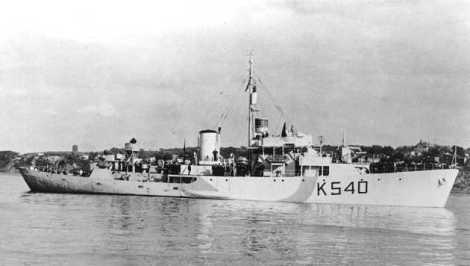
One 102/40 QF Mk XIX, one 40mm/39 2pdr QF Mk VIII or two twin 20mm/70 Oerlikon Mk II/IV, two 20mm/70 Oerlikon Mk II/IV or four single 20mm/70 Oerlikon Mk II/IV, and the usual one twenty-four tubes 178 Hedgehog ASWRL, 4 DCT, 2 DCR (100 deep charges in stock). The othr difference with British-built ships were their sincle VTE engine with 2 Admiralty 3-drum boilers instead of the British 2 cylindrical boilers.
Type 271Q/type 273/type 291 radars, type 144 sonar. The two wartime losses were the HMCS Trentonian on 22/2/1945 sunk by German submarine U1004 and HMCS Merrittonia lost in a navigation accident on 30/11/1945.
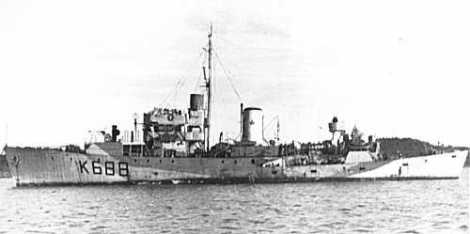
 Castle corvettes (HESPELER class, 1944)
Castle corvettes (HESPELER class, 1944)
The Castle class were a late wartime development of the “Flower” class, with larger dimensions toresolve previous issues of bad habitability and small fuel stowage. The machinery was almost unchanged but the hull had a better lenght-to-width ratio. Top speed was the same. However they had a major ace of their sleeve: The brand new Squid ASW system.
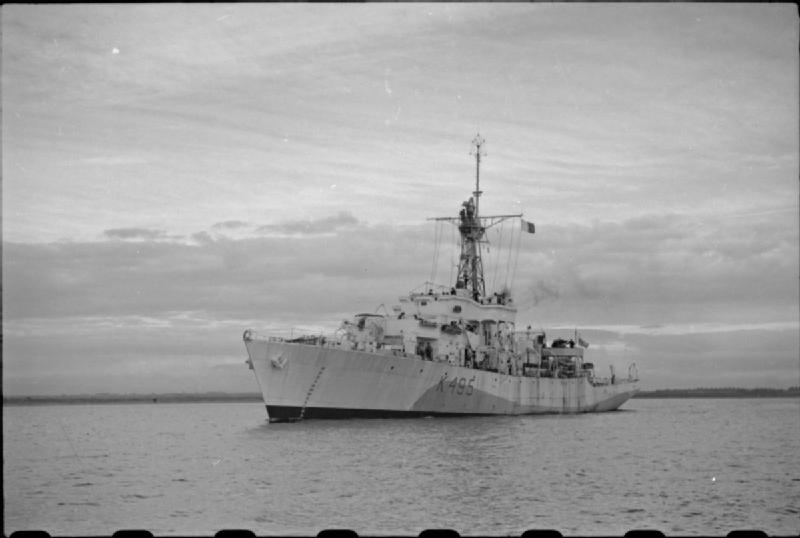
HMS Coopercliff
The 1942 and 1943 programsplanned 59 ships, but only 39 entered service as convoy rescue ships and carried awith merchant flag, ou of the Navy. They had two 76mm/40 guns and four 20mm Oerlikons. The remaining order was cancelled. All the ships were consequently built in UK: Harland & Wolff (Belfast), Pickersgill (Sunderland), Blyth, Robb (Leith), Ailsa (Troon), Inglis (Glasgow), Smiths Dock (South Bank).
They were the HMCS Arnprior, Bowmanville (ex-Nunnery Castle), Copper Cliff (ex-Hever Castle), Hespeler (ex-Guilford Castle), Humberstone (ex-Norham Castle, ex-Totnes Castle), Huntsville (ex-Wolvesey Castle), Kincardine (ex-Tamworth Castle), Leaside (ex-Walmer Castle), Orangeville (ex-Hedingham Castle), Petrolia (ex-Sherborne Castle), St. Thomas (ex-Sandgate Castle), Tillsonburg. They were completed between February and September 1944 and saw little wartime service. None was lost in action.
 Motor Torpedo/ASW vessels
Motor Torpedo/ASW vessels
-This comprised a single CMTB1 motor torpedo boat (1941) built in Montreal, it was propelled by two Packard petrol engines, was capable of 40 knots and armed with two twin 12.7mm/62, 12 DC or 4 mines.
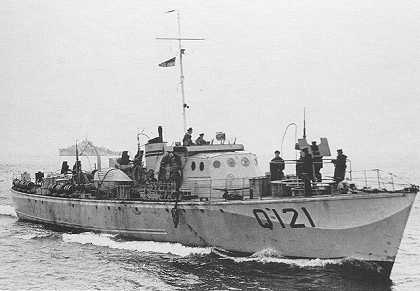
Q121 Fairmile D
BPB serie: A serie of British Power Boats made at Hythe: 10 boats, MTB459-467, 485, 486, 491. There were seven losses in action. They were armed with one 57mm/43 6pdr 7cwt QF Mk II, two 20mm/70 Oerlikon Mk II/IV, two twin 7.7mm/94, and two 450mm TT, plus 2 DC. 3 Packard engines propelled them to 38-40 knots. They were the 70-ft BPB design fitted with the type 291U radar.
-Fairmile D motor torpedo boats (1944): All built in UK and transferred, MTB726, 727, 735, 736, 743-748, and 797, ten ships in all. Two 57mm/43 6pdr 7cwt QF Mk II, and a twin 20mm/70 Oerlikon Mk II/IV, two twin 12.7mm/62, two twin 7.7mm/94, and four 450 TT, plus 2 DC. These 118 ton ships type were fitted with the 291U or type 293 or type 268U or SO radar. They were the main patrol ships of the RCN. They were modernized AA-wise, with two twin 12.7mm/62 and two 20mm/70 Oerlikon Mk II/IV.
-Fairmile C patrol boats (1944):
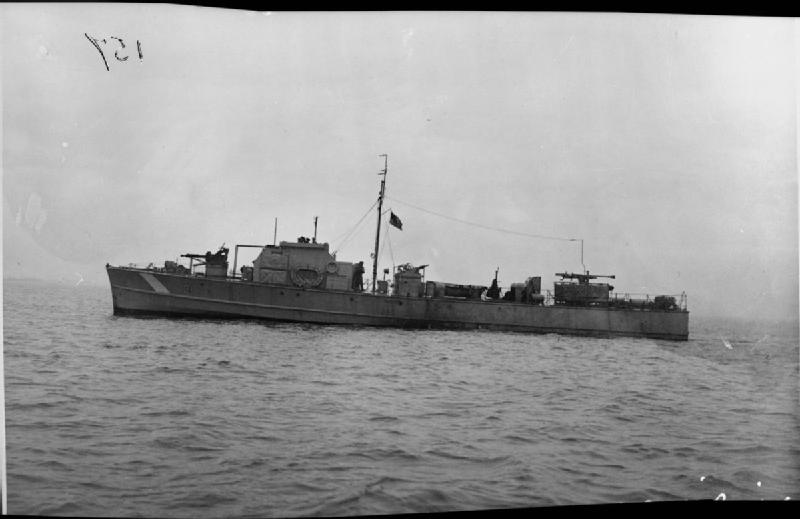
MGB-316 Fairmile C
Theses successful multi-purpose boats could be used as minesweepers, minelayers and ASW boats. Built in UK, in Wooden, they had a round-bilge hull. Canadian ML001-080 were renamed ML050-129.
In the end of 1940 some have received two 533 TT removed from former American flushdeckers. Canadian Fairmiles were not commissioned and not named, until sold off. About 79 were in service. Due to their wooden construction they were built in Burland (Bermuda) ML368, 369, Belmont Dock (Kingston, Jamaica) ML378, 379, other were built in Canada, at Midland SY: ML050, 051, 081, 082, 094, 095, 108, 118, Taylor, Toronto: ML052, 053, 079, 080, 086 – 088, 112, 113, Greavette, Gravenhurst: ML054 – 056, 077, 078, 089 – 091, 114, Minette-Shields, Bracebridge: ML057 – 059, 074 – 076, 096, 097, 110, 119, Hunter, Orillia: ML060, 061, 085, 092, 093, 109, 116, Mac Craft, Sarnia: ML062, 063, 101 – 105, 115, Vancouver SYd: ML066, 067, 122 – 124, Benson, Vancouver: ML068, 069, 128, 129, Star SB, New Westminster: ML070, 071, 125 – 127, Grew, Pentetanguishene: ML072, 073, 098 – 100, 106 – 107, 117, and Le Blanc SB (Weymouth) (ML393). The only loss registered was the ML082 (in January 1945, damaged, but never repaired).
————
Submarines
The only ones in service (after four WW-1 era boats decommissioned in the 1920s), the HMCS U-190 and U-889, which surrendered and were recommissioned for study and exercizes. Older WW-1 era ones served for a time in the interwar, of British and US origin.
Mine warfare vessels
 Melville class minesweepers (1941)
Melville class minesweepers (1941)
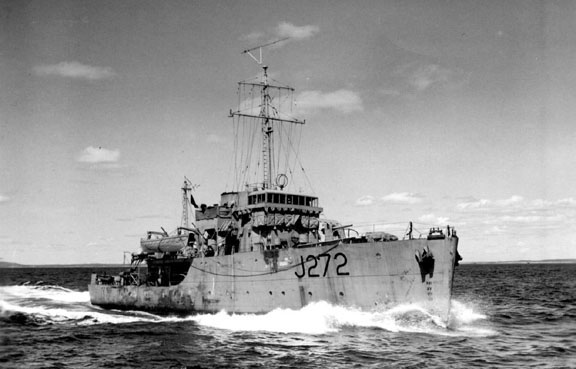
HMCS Esquimalt in happier times. Torpedoed and sunk by U-190 on 16 April 1945. Credit: Department of National Defence.
Ten Bangor-class vessels built in Canada, HMCS Brockville, Sorel, Digby, Esquimalt, Granby, Lachine, Melville, Noranda, Transcona, Trois Rivieres, and Truro. They were from Marine Industries, Sorel and Davie SB, Lauzon, completed in 1942. Standard armament was one 76mm/40 (3-in) 12pdr 12cwt QF Mk I/II/V, 4 DCT, and 2 DCR. They were given a type 286PU radar and a type 128 sonar. HMCS Esquimalt was the onl wartime loss, sunk by German submarine U190 near Halifax in 16/4/1945. These ships stayed in service as coastal escorts in 1953.
 COWICHAN class minesweepers (1942)
COWICHAN class minesweepers (1942)
44 ships of the same type (Bangor) built later with some modifications: Their armament varied widly: One 76mm/45 20cwt QF Mk I/II/III/IV or a single 76mm/40 12pdr 12cwt QF Mk I/II/V, a single 40mm/39 2pdr QF Mk VIII or four 12.7mm/6. The usual ASW provision was 4 DCT, 2 DCR (and 40 DC in ASW role). Their electronics suite comprised the type 128 sonar and from mid-1942, the type 286PU radar (for some), and type 128 sonar. Their machinery comprised a compact high-speed VTE unit. The 67 ships were built bt Canadian and Indian yards. There was just one wartimle loss, HMCS Mulgrave, which was badly damaged by a mine 8/10/1944 and never repaired, Clayoquot sank on 24/12/1944 by U806 near Halifax, HMCS Guysborough was sunk in 17/3/1945 by U878 in the bay of Biscay and HMCS Chedabucto was lost on 21/10/1943 in a collision with s/s Lord Kelvin. They stayed in service after the war, until 1956-58, modernized and resold.
 LLEWELLYN class Admiralty-type motor minesweepers (1942)
LLEWELLYN class Admiralty-type motor minesweepers (1942)
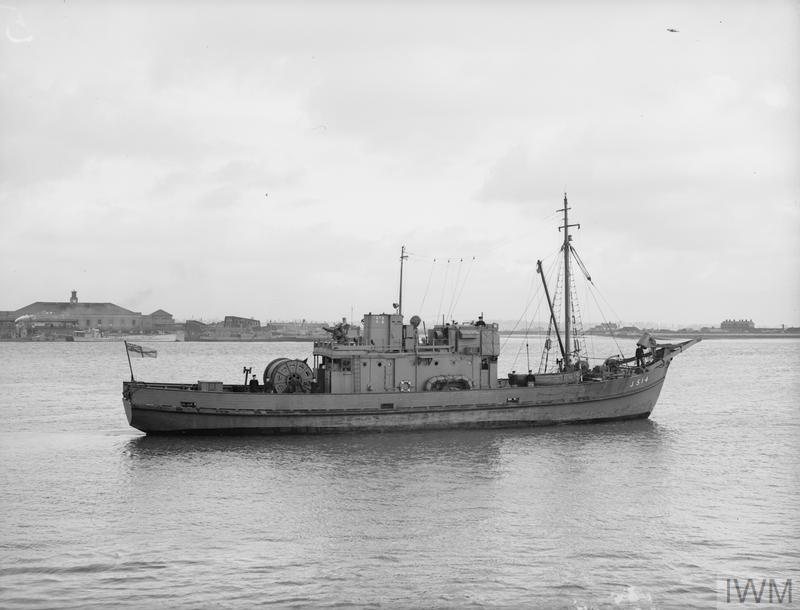
MINESWEEPERS. 18 MARCH 1942, GRAVESEND. (A 9736) Motor Minesweeper J514. IWM. Original Source: http://www.iwm.org.uk/collections/item/object/205143529
Ten ships built in Canada, called Coquitlam, Cranbrook, Daerwood, Kalamalka, Lavallee, Llewellyn, Lloyd George, Revelstoke, Rossland, St. Joseph. These admiralty coastal minesweepers were highy successful, often called the “102 ft type”. Thet were armed with one 20mm/70 Oerlikon Mk II/IV, a twin 12.7mm/62 and in alternative two twin cal.50 or two 20mm/70 Oerlikon Mk II/IV. Their ASW suite comprised a mechanical, magnetic, acoustic and minesweeping gear.
 SAULT STE. MARIE class minesweepers (1943)
SAULT STE. MARIE class minesweepers (1943)
Twenty-nine ships built at Redfern, Toronto and Port Arthur SY. These ships displaced 1235 – 1325 tons. Their machinery comprised two VTE engines fed by two Admiralty 3-drum boilers. They were armed with a single 102mm/45 QF Mk V, and four 20mm/70 Oerlikon Mk II/IV or in alternative four twin 20mm/70 Oerlikon Mk II/IV, 4 DCT and 2 DCR (90 to 92 deep charges). They were fitted with a Type 271 or type 272, or even a type 291 radar for some ships and a type 128 sonar.
48 ships were built in British yards (29 with turbines and 19 with VTE). 62 ships were built on Canadian yards, including 19 ordered by the Royal Navy. 15 were once intended for the USN as “reverse” lend-lease, but this was cancelled. Of the 28 ships intended for the RCN, 16 were transferred to the Royal Navy.
 HICKORY LAKE class minesweepers (1945)
HICKORY LAKE class minesweepers (1945)
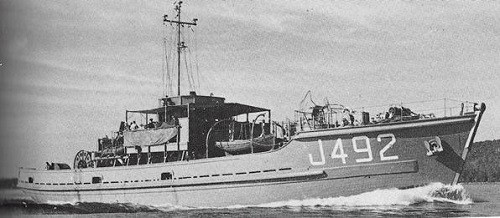
HMCS Pine Lake – Source
These were 126ft Admiralty-type motor minesweepers, built in Canada at Midland SB, Vancouver SY, Port Carling SB, Taylor, Toronto, Mac Craft, Sarnia, Grew Boats, Pentetanguishene, Clare SB, Methaghan, Star SY, New Westminster, Newcastle SB, Nanaimo. These were sixteen ships with “lake” names. They were armed with 20mm/70 Oerlikon Mk II/IV or two twin 20mm/70 Oerlikon Mk II/IV, mechanical, magnetic, acoustic minesweeping gear. het were enlarged variant of 115ft MMS with Wooden hull, acoustic and magnetic sweeping gears. None was sunk in wartime, and ten has been trasnferred to USSR via lend-lease in 1945.
 FUNDY class armed trawlers (1938)
FUNDY class armed trawlers (1938)
HMCS Comox, Fundy, Gaspé and Nootka in 1944 were built Burrard (Vancouver), Collingwood, Morton (Quebec City), and Canadian Yarrow (Esquimalt). They were armed with a 102mm/40 QF Mk IV, four 7.7mm/87, 2 DCT, 2 DCR (4), and a mechanical minesweeping gear. No loss and they were resold to China in 1946-47.
 BAFFIN class armed trawlers (1942)
BAFFIN class armed trawlers (1942)
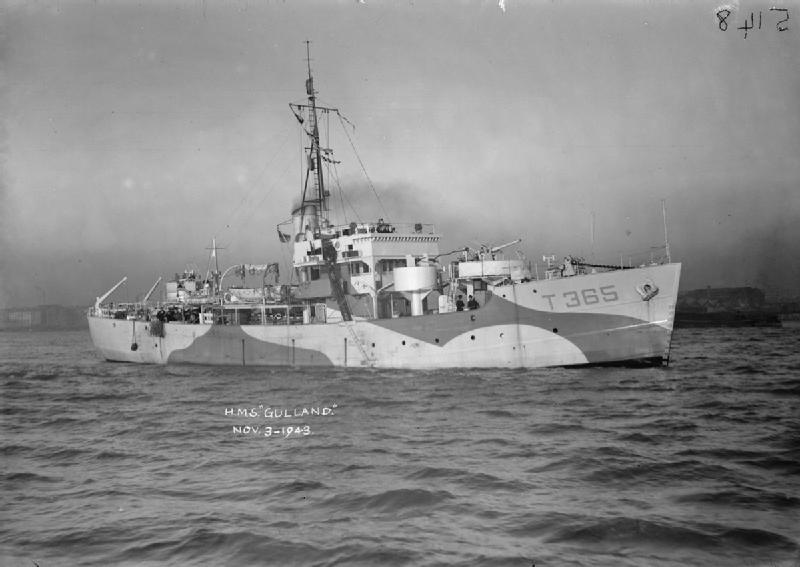
HMT Gulland of the same type.
The class comprised eight ships, the HMCS Anticosti, Baffin, Bowell, Cailiff, Ironbound, Liscomb, Magdalen, Manitoulin, and they were two controlled minesweepers, Stonechat and Whitethroat (made at Cook, Welton & Gemmell, Hull, UK). They were developments of the Basset class, for minesweeping, built at Collingwood SY, Kingston SY and Midland SB. They were armed with one 76mm/40 12pdr, 12cwt QF Mk I/II/V, three 20mm/70 Oerlikon Mk II/IV, four DCT, two DCR (30), and mechanical minesweeping gear.
Miscellaneous ships
LSI(L) large infantry landing craft:
32 ships, from Bethlehem (Hingham), Federal (Newark) and New Jersey SB (Barber). They were transferred to the RN in 1943-44 and later passed on to the RCN. They were armed with one 40mm/39 2pdr QF Mk VIII, three 20/70 Oerlikon Mk II/IV. Returned to UK in 1944.
Canadian Armed Merchant Cruisers
Three identical vessels served with the RCN: Prince David (F89), Prince Henry (F70), and Prince Robert (F56). They were made at Cammell Laird, Birkenhead, of 6892 tons, armed with four 152mm/45 Mk VII (20) (6-in), and two 76mm/45 (3-in). Two were converted as LSI(M) in Dcember 1943 and one as AA ship in june 1943.
Other auxiliaries
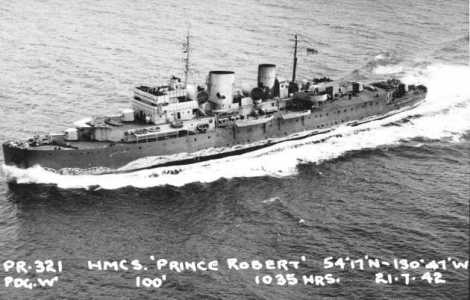
HMCS Prince Robert, auxiliary cruiser, until the arrival of the cruisers in 1944, the largest ship in service. SRC
-Nine auxiliary patrol and ASW vessels, requisitioned in 1939-40 and in use until 1945. These were the Cartier, French, Laurier, Macdonald, Macsin, Murray Stewart, Nitinat, St. Anne, Shulamite.
-Prince Robert, a sea-going auxiliary AA ship: A 6892 GRT 1930 steamship built at Cammell Laird, Birkenhead, armed with ten 102mm/45 Mk XVI, and four 20mm/70 AA Oerlikon guns. She was modelled after the AA “C” class cruisers armament model. She was commissioned in June 1943.
-One ship requisitioned for transformation but never completed: Lady Nelson, a 7970 GRT vessel from Cammell Laird, Birkenhead. She was to be an ABV intended for patrol and boarding service.
-22 armed yachts, requisitioned by the admiralty in 1940 and armed with a 3-in gun (76 mm) or a variable dotation. Ambler, Beaver, Caribou, Cougar, Elk, Fifer, Fleur de Lis, Grizzly, Husky, Lynx, Magedoma, Moose, Otter, Raccoon, Reindeer, Renard, Sans Peur, Ulna, Vencedor, Venetia, Vison, and Wolf.
-Auxiliary trawlers used as minesweepers: Bras dOr, Comber, Rayon dOr, Venosta, Vercheres, Viernoe and whalers, the Star XVI, Suderoy IV, Suderoy V and Suderoy VI. They were also the Ocean Eagle, Reo II, Ross Norman, Spray, and Standard Coaster. Their tonnage ranged between 100 and 1000 BRT.

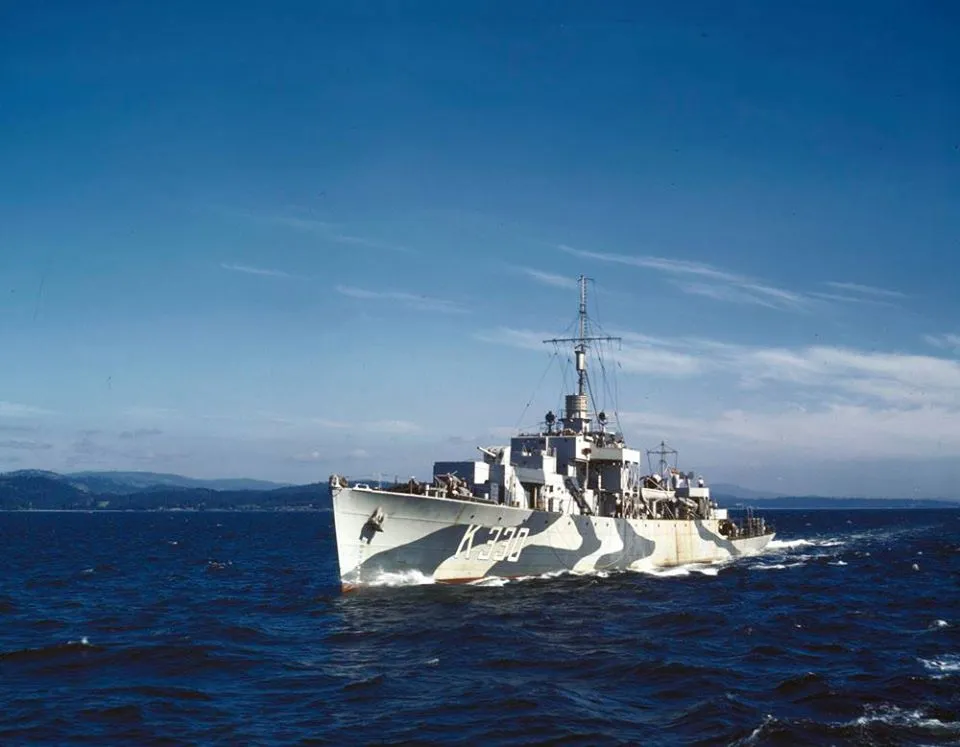
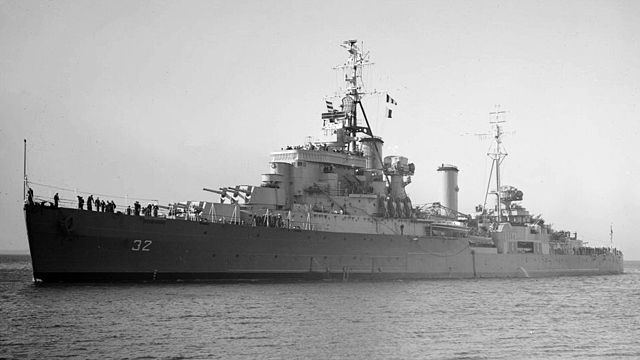
 Latest Facebook Entry -
Latest Facebook Entry -  X(Tweeter) Naval Encyclopedia's deck archive
X(Tweeter) Naval Encyclopedia's deck archive Instagram (@navalencyc)
Instagram (@navalencyc)





 French Navy
French Navy Royal Navy
Royal Navy Russian Navy
Russian Navy Armada Espanola
Armada Espanola Austrian Navy
Austrian Navy K.u.K. Kriegsmarine
K.u.K. Kriegsmarine Dansk Marine
Dansk Marine Nautiko Hellenon
Nautiko Hellenon Koninklije Marine 1870
Koninklije Marine 1870 Marinha do Brasil
Marinha do Brasil Osmanlı Donanması
Osmanlı Donanması Marina Do Peru
Marina Do Peru Marinha do Portugal
Marinha do Portugal Regia Marina 1870
Regia Marina 1870 Nihhon Kaigun 1870
Nihhon Kaigun 1870 Preußische Marine 1870
Preußische Marine 1870 Russkiy Flot 1870
Russkiy Flot 1870 Svenska marinen
Svenska marinen Søværnet
Søværnet Union Navy
Union Navy Confederate Navy
Confederate Navy Armada de Argentina
Armada de Argentina Imperial Chinese Navy
Imperial Chinese Navy Marinha do Portugal
Marinha do Portugal Mexico
Mexico Kaiserliche Marine
Kaiserliche Marine 1898 US Navy
1898 US Navy Sovietskiy Flot
Sovietskiy Flot Royal Canadian Navy
Royal Canadian Navy Royal Australian Navy
Royal Australian Navy RNZN Fleet
RNZN Fleet Chinese Navy 1937
Chinese Navy 1937 Kriegsmarine
Kriegsmarine Chilean Navy
Chilean Navy Danish Navy
Danish Navy Finnish Navy
Finnish Navy Hellenic Navy
Hellenic Navy Polish Navy
Polish Navy Romanian Navy
Romanian Navy Turkish Navy
Turkish Navy Royal Yugoslav Navy
Royal Yugoslav Navy Royal Thai Navy
Royal Thai Navy Minor Navies
Minor Navies Albania
Albania Austria
Austria Belgium
Belgium Columbia
Columbia Costa Rica
Costa Rica Cuba
Cuba Czechoslovakia
Czechoslovakia Dominican Republic
Dominican Republic Haiti
Haiti Hungary
Hungary Honduras
Honduras Estonia
Estonia Iceland
Iceland Eire
Eire Equador
Equador Iran
Iran Iraq
Iraq Latvia
Latvia Liberia
Liberia Lithuania
Lithuania Mandchukuo
Mandchukuo Morocco
Morocco Nicaragua
Nicaragua Persia
Persia San Salvador
San Salvador Sarawak
Sarawak Uruguay
Uruguay Venezuela
Venezuela Zanzibar
Zanzibar Warsaw Pact Navies
Warsaw Pact Navies Bulgaria
Bulgaria Hungary
Hungary

 Bundesmarine
Bundesmarine Dutch Navy
Dutch Navy Hellenic Navy
Hellenic Navy Marina Militare
Marina Militare Yugoslav Navy
Yugoslav Navy Chinese Navy
Chinese Navy Indian Navy
Indian Navy Indonesian Navy
Indonesian Navy JMSDF
JMSDF North Korean Navy
North Korean Navy Pakistani Navy
Pakistani Navy Philippines Navy
Philippines Navy ROKN
ROKN Rep. of Singapore Navy
Rep. of Singapore Navy Taiwanese Navy
Taiwanese Navy IDF Navy
IDF Navy Saudi Navy
Saudi Navy Royal New Zealand Navy
Royal New Zealand Navy Egyptian Navy
Egyptian Navy South African Navy
South African Navy






























 Ukrainian Navy
Ukrainian Navy dbodesign
dbodesign